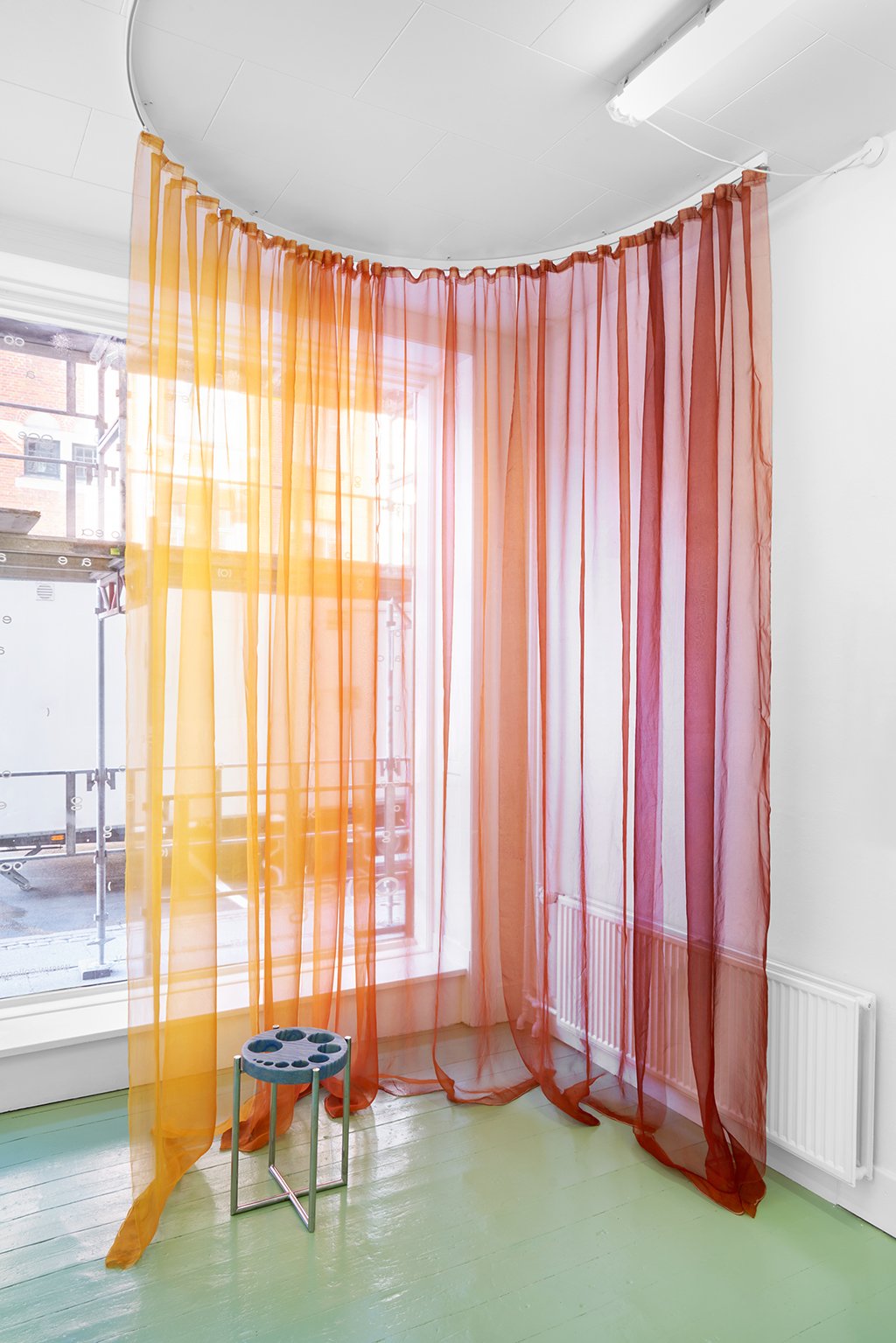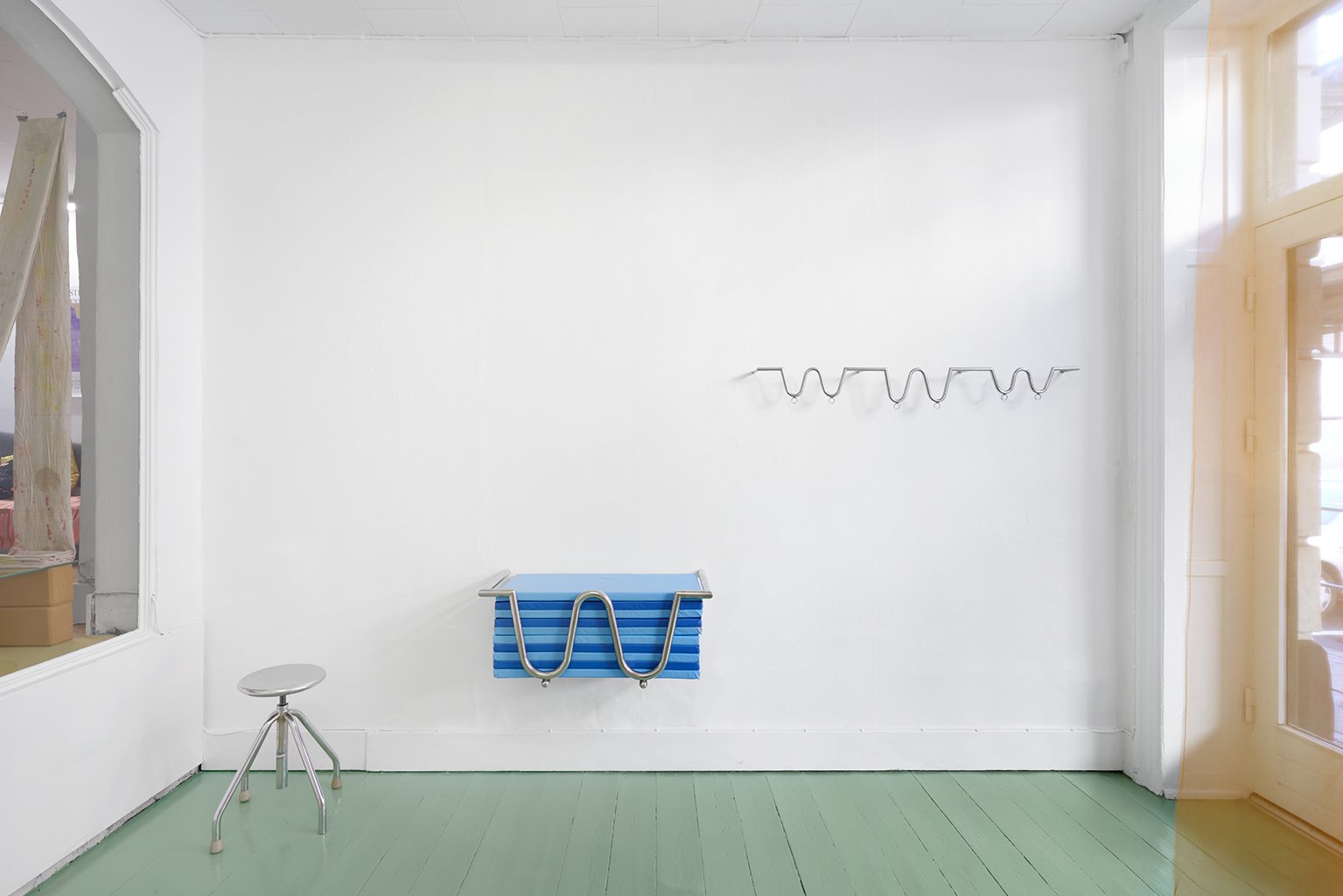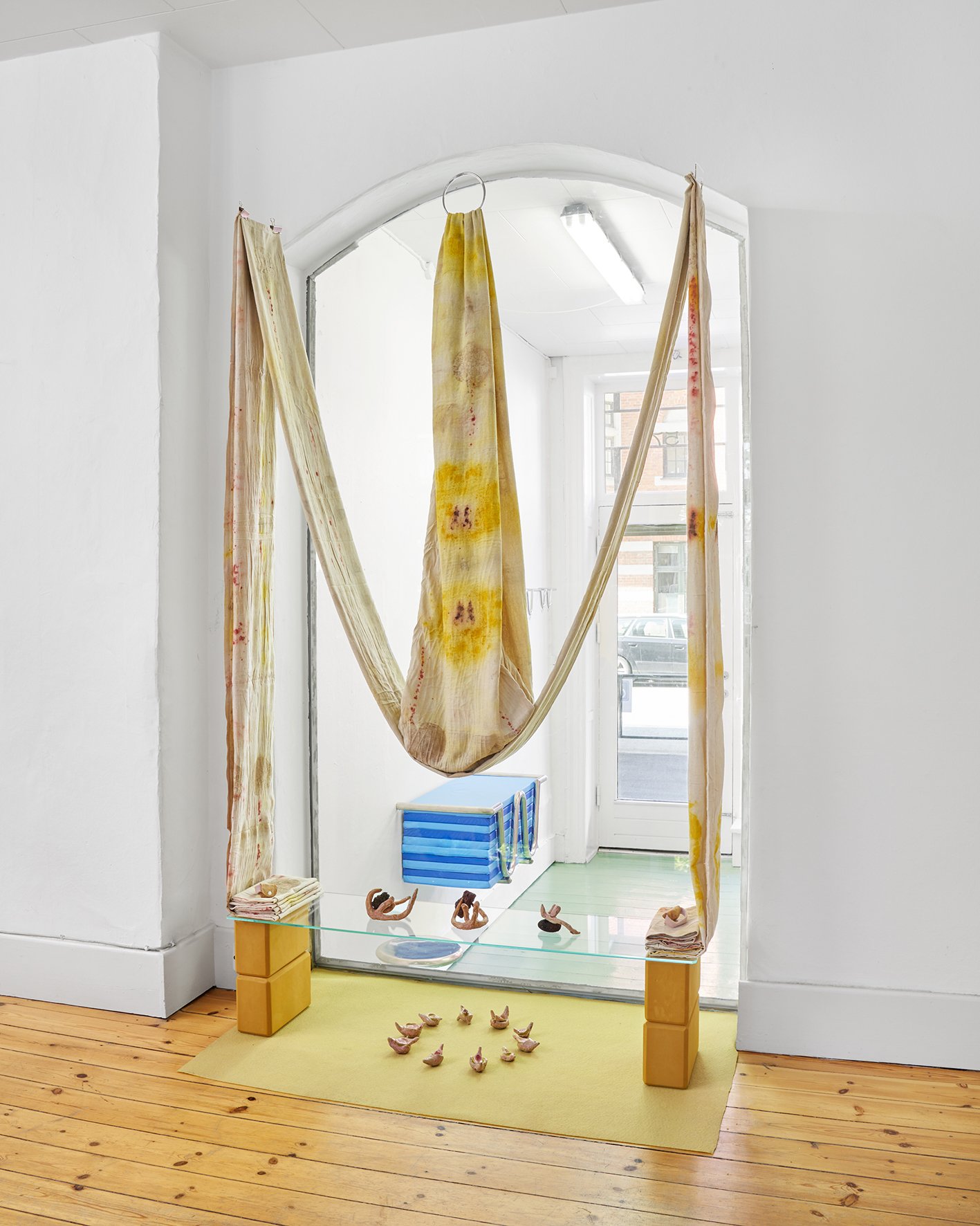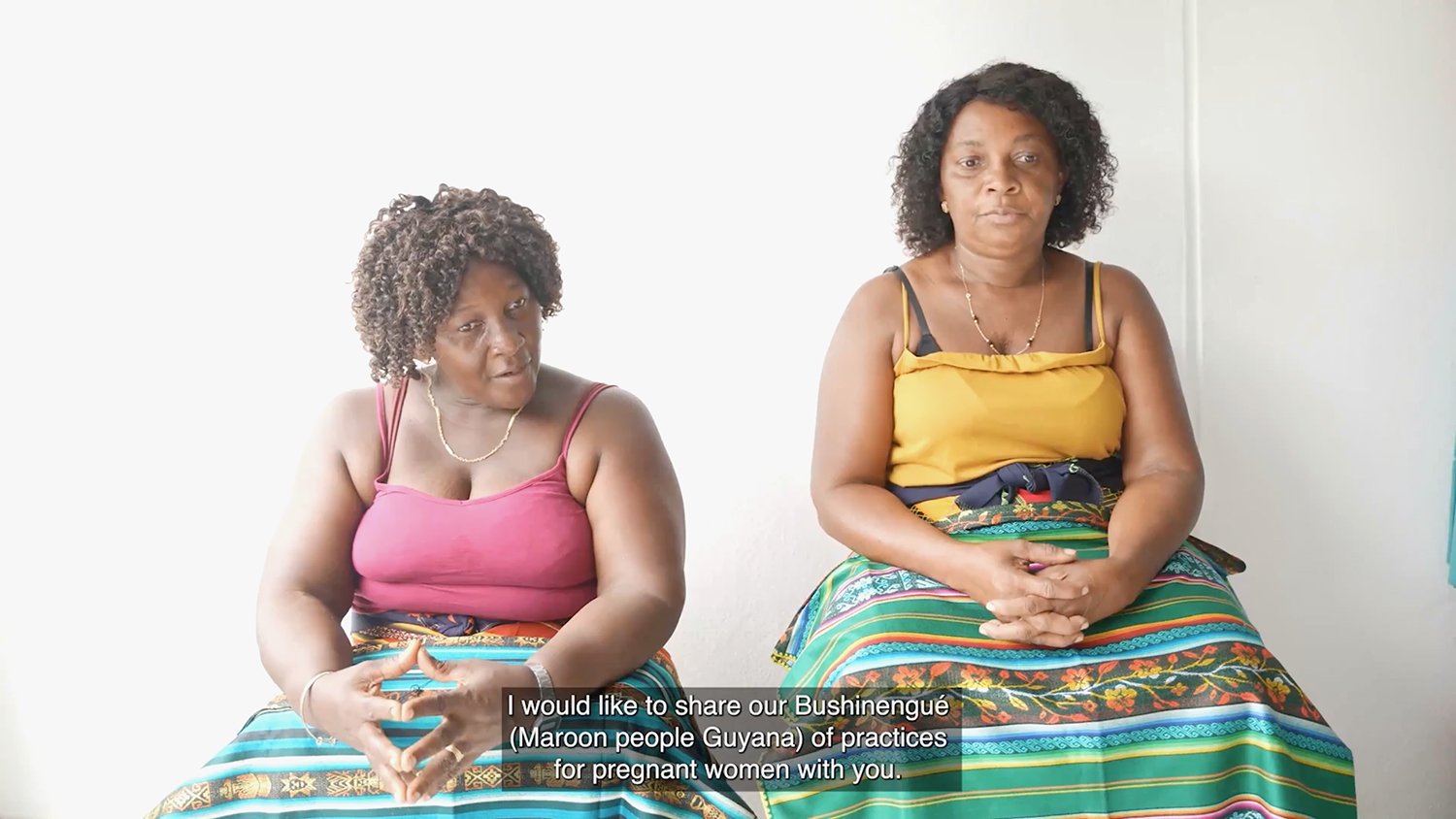Collega Group, The Birthkeeper Altar. Photo: Graysc.
Press release, september 2023
With the marginalization of the midwife, the process began by which women lost the control they had exercised over procreation, and were reduced to a passive role in child delivery (...) the community of women that had gathered around the bed of the future mother had to be first expelled from the delivery room, and midwives had to be placed under the surveillance of the doctor, or had to be recruited to police women. (Silvia Federici 2004: 89)
Two years ago, when I was planning the exhibition programme for Collega, I asked Tabita Rezaire – an artist who runs the AMAKABA art space in French Guiana – to co-curate a show representing AMAKABA and their work. Rezaire accepted the invitation but did not feel comfortable curating an exhibition. Instead, she proposed a framework for our collaboration. Rezaire suggested that we transform Collega into a doula centre for the duration of the exhibition. Since Rezaire had been my long-distance doula during my pregnancy, it felt appropriate to explore the concept of doula practice together.
Collega Group, The Birthkeeper Altar. Photo: Graysc.
Collega Group, The Birthkeeper Altar. Photo: Graysc.
Collega Group, The Birthkeeper Altar. Photo: Graysc.
The term “doula” has its origins in the ancient Greek word “doule” or servant-woman. In modern times it refers to a person who is trained to provide information, emotional support, and physical comfort to a mother before, during, and after childbirth. However, doulas can also be trained to assist with various life transitions, including death, gender transition, first period, and menopause. In recent years, there has been an increase in the utilisation of doulas during childbirth in Denmark, mostly among the privileged few. This rise in popularity can be attributed to ongoing budget cuts faced by Danish hospitals since 2002, with doulas stepping in to do the care work that the hospital system is sometimes unable to deliver.
Collega Group, The Birthkeeper Altar. Photo: Graysc.
As the philosopher Silvia Federici highlighted, childbirth experienced a power shift in 16th century Europe. In the Danish context, reproductive health issues such as birth control, abortion, and childbirth were traditionally overseen by “kloge koner” or wise women. However, with the introduction of the Danske Lov – the Danish statute book of 1683 – these practices underwent significant changes. Abortion, the abandonment of newborns, and giving birth without the assistance of an authorised midwife were criminalised. Local midwives were tasked with inspecting the breasts of unmarried women to check for milk in cases of infant abandonment. (1) The punishment for such acts was decapitation, with the head of the condemned woman to be displayed on a pole in public space after her execution. This shift in the role of midwives contrasted with the previous practices and beliefs of traditional healers, who were increasingly stigmatised and condemned as witches for using or sharing their knowledge. (2)
For The Birthkeeper Altar, we invited artist and doula Nanna Lysholt to host a workshop programme. Additionally, we invited artist Lea Gulditte Hestelund and author Olga Ravn to collaborate on an installation, presented alongside a video by AMAKABA.
Collega Group, The Birthkeeper Altar. Photo: Graysc.
Collega Group, The Birthkeeper Altar. Photo: Graysc.
Nanna Lysholt has been exploring themes of birth and motherhood since 2013 through her art project Dear Daughter (2013-2023), a series of voice-based live performances and audio-video installations. In recent years she has merged her artistic practice with doula practice, and the exhibition will feature some of Lysholt’s doula remedies – tools for acupressure, calming scents, and ecoprinted textile – in a joint sculpture Kore (Maman) (2023). As part of her workshop program, Lysholt has invited Marta Orbis, a midwife and doula colleague. Orbis, having learned the rebozo practices from traditional Mexican midwives introduced rebozo practices to Danish doulas and midwives, with rebozo eventually being used by the Danish hospital system.
Collega Group, The Birthkeeper Altar. Photo: Graysc.
Collega Group, The Birthkeeper Altar. Photo: Graysc.
Collega Group, The Birthkeeper Altar. Photo: Graysc.
“Rebozo” is a Spanish term used to describe a shawl or scarf and encompasses various ancient techniques in which the shawl is used as an extension of the hands. It can be used to carry a baby, as a bag, or as a massage tool. During childbirth, it serves as an extension of the birth helper’s hands to perform massage techniques before and during pregnancy, as well as during labour. It can also be used as a tool to assist in a “closing ceremony” after a birth. For her workshop program, Lysholt has created plant-dyed, eco-printed rebozos that will be used by Lysholt and Orbis to perform elements of a postpartum ceremony. This ceremony, known as the “closing of the bones” represents the transition from the openness of the body and soul after birth to the return to a core connection.
Collega Group, The Birthkeeper Altar. Photo: Graysc.
The Birthkeeper Altar space is designed by Olga Ravn and Lea Guldditte Hestelund. The two artist’s collaboration began with Hestelund’s solo exhibition at Overgaden in 2018, which referenced carriers such as a womb, or a bag – with Ravn’s science fiction novel, The Employees (2018), which was published for the exhibition. Ravn is an author whose novel My Work (2020) explores postpartum depression and the liminal space surrounding childbirth. In addition to her writing, Ravn is a visual artist, often working with textiles. For The Birthkeeper Altar, Ravn is presenting Curtain Between Now and Then (2023) handdyed silk textiles using madder root, a plant dye source that has been used for over 4,000 years, as well as weld flower, known for its calming properties. Similarly, Hestelund has been exploring themes of birth and motherhood in her practice, most recently in her exhibition Hissy Fit (2022), which showcased a series of safety wear designed to protect broken bodies. In addition to Ravn’s fabric, Hestelund has designed CDT (cervical dilation table) (2023) that takes inspiration from a chart used for birth education. Hestelund has also created wall carriers Hang I, II, III (2023) for folding mattresses and coat hangers for visitors participating in workshops and exhibition guests.
Collega Group, The Birthkeeper Altar. Photo: Graysc.
AMAKABA is represented in the space with the 56 minute video work L’art de Naitre (2022). This video explores the wisdom of birth through the experiences of four traditional midwives who, from their respective traditions, have provided support and care during the initiation of motherhood. These women include Mrs Yapara from the indigenous Lokono tradition, Odette Majokko and Noria Majokko from the Maroon Saramaka tradition, and Mrs Myriam Kerrel from the Creole tradition. The video serves as a glimpse into AMAKABA’s research process and Tabita Rezaire’s journey as a doula, influenced by her grandmother and great-grandmother, both of whom were midwives.
AMAKABA, L’art de Naitre (2022).
AMAKABA, L’art de Naitre (2022).
Coincidentally, while I was deep in research for The Birthkeeper Altar, I was asked by my childhood friend Camilla to be present at the birth of her child. The experience left me with a deep sense of gratitude for those who commit to assisting and supporting birthing people – doulas, midwives, nurses, doctors, friends and co-parents. The Birthkeeper Altar at Collega seeks to celebrate them and bring attention to the historical and cultural context surrounding childbirth.
Lotte Løvholm, Collega
AMAKABA is a vision for collective healing in the Amazonian forest of French Guiana. Initiated by artist and doula Tabita Rezaire, it is a place for the arts and sciences of earth, the body and the sky. AMAKABA is part of a global movement that advocates for conscious births and focuses on training doulas and building a network of birth workers and traditional midwives in French Guiana.
Collega focuses on co-curation as practice, and each exhibition is curated in collaboration with a collective or an institution abroad. Collega is supported by Bikuben Foundation, The Danish Arts Foundation, Beckett-Fonden, Augustinus Fonden, William Demant & Rådet for Visuel Kunst.
Exhibition period: 7 September - 14 December, 2023.
Curators: Tabita Rezaire, AMAKABA & Lotte Løvholm, Collega.
Artists: Lea Gulditte Hestelund, Nanna Lysholt, Olga Ravn & Tabita Rezaire.
Sub-editing: Nathaniel Budzinski
Graphic identity: Beate Bloch Christensen
Production assistance: Elif Temizkan, Director of Arts & Cultural Development, AMAKABA.
Thank you Birk Bjørlo, Jacob Remin, Marie Kølbæk Iversen and Camilla Ingemann Parby.
Thanks to all participants in the workshop and performance.
Christina Lysbjerg Mogensen: “Danske Lov 1638” on danmarkshistorien.dk, AAU, March 2021.
Marie Kølbæk Iversen, Neo-worlds: Transformative Agency through Fright, Rite, and Myth, 2023: 30-31. Doctoral thesis, Oslo National Academy of the Arts.














